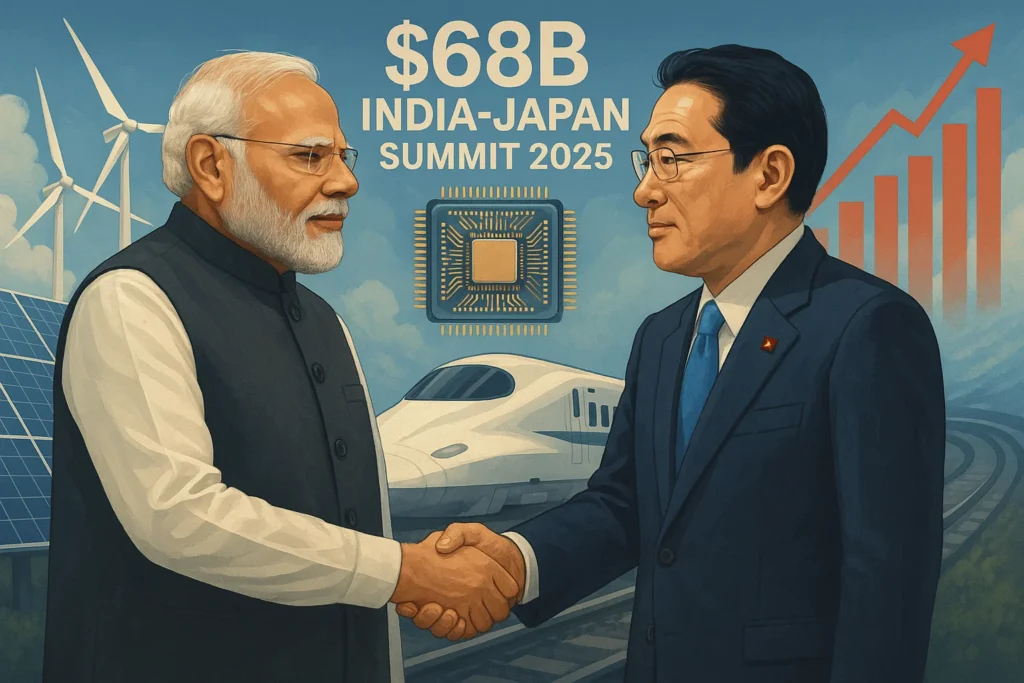India-Japan Summit 2025
The India-Japan Summit 2025, held on August 29 in New Delhi, has turned out to be one of the most defining geopolitical and economic events of the year. With Japanese Prime Minister Shigeru Ishiba and Indian Prime Minister Narendra Modi announcing an unprecedented $68 billion investment commitment over the next decade, the summit has sent ripples across multiple sectors in India.
For retail investors, this isn’t just a diplomatic headline—it’s a potential game changer. From clean energy to semiconductors, and from infrastructure to human capital development, the deals signed during this summit promise to reshape India’s economic landscape and open up new opportunities in the stock market.
Let’s break it down step by step: the investments, the sectors, the numbers, and most importantly, the stocks that could benefit from the India-Japan partnership.
A Quick Recap of the India-Japan Summit 2025
At the core of the summit was the vision of transforming India into a manufacturing, technology, and clean energy hub, while deepening Japan’s role as a strategic investor and partner.
Here are the key announcements:
- $68 Billion Investment: Japan will deploy this capital in India over the next 10 years.
- Focus Areas: Clean energy, infrastructure, semiconductors, AI, and human capital.
- Talent Exchange: Nearly 500,000 skilled Indian workers and students will gain opportunities in Japan.
- Strategic Supply Chains: Both countries agreed to develop joint supply chains for critical minerals, semiconductors, and batteries.
- High-Speed Rail: The much-anticipated Mumbai-Ahmedabad bullet train project received renewed backing.
This is not just a symbolic partnership. It’s about channeling capital, technology, and expertise into sectors that are already on a strong growth trajectory in India.
Clean Energy: Powering India’s Green Transition
One of the standout themes of the summit was the emphasis on clean energy. Out of the total investment pool, nearly $20 billion is expected to flow into renewables, green hydrogen, and biofuels.
India is already one of the fastest-growing clean energy markets in the world, with a target of achieving 500 GW of renewable capacity by 2030. The market size for renewable energy in India stood at $20 billion in 2024 and is projected to surpass $80 billion by 2030.
So what does Japan’s investment bring to the table? For one, Japanese firms have global expertise in solar, hydrogen, and biofuel technology, which India can leverage to scale up production and efficiency.
For investors, this could translate into opportunities in listed companies such as:
- Large Cap: NTPC (pushing aggressively into renewables), Adani Green Energy
- Mid Cap: ReNew Energy Global, KPI Green
- Small Cap: Waaree Energies, Gensol Engineering
Japan’s capital injection could accelerate projects in solar and green hydrogen, pushing valuations of these players higher.
Technology & Semiconductors: Building India’s Silicon Future
Another major takeaway was the agreement on semiconductors, AI, and digital technologies. Japan has committed around $12 billion towards technology partnerships and supply chain development.
India’s semiconductor market, which stood at $34 billion in 2024, is projected to hit $100 billion by 2030. With India aspiring to build fabs and Japan being a leader in chip equipment and raw materials, this is a win-win collaboration.
For retail investors, the beneficiaries could be:
- Large Cap: Tata Elxsi, HCL Tech (AI & semiconductor design)
- Mid Cap: Dixon Technologies (electronics manufacturing), MosChip (chip design)
- Small Cap: SPEL Semiconductors, ASM Technologies
The India-Japan semiconductor pact is more than just investment—it’s about securing India’s position in the global chip supply chain at a time when the world is de-risking from China.
Infrastructure & Smart Cities: The $25 Billion Push
Infrastructure is where Japanese investments have historically made a difference. Think of Delhi Metro, which was built with Japanese financing and technology. At this summit, Japan reaffirmed its commitment with $25 billion earmarked for infrastructure, high-speed rail, and smart cities.
India’s infrastructure market is already booming, expected to grow from $120 billion in 2024 to $280 billion by 2030. With Japanese capital, projects like the Mumbai-Ahmedabad bullet train and new industrial corridors will gain momentum.
Potential stock beneficiaries include:
- Large Cap: Larsen & Toubro, IRCON International
- Mid Cap: NBCC, HG Infra, Rail Vikas Nigam Ltd (RVNL)
- Small Cap: PSP Projects, KNR Constructions
This investment also aligns with India’s push for urbanisation, smart mobility, and logistics efficiency, sectors that can significantly boost GDP growth.
Human Capital & Talent Exchange: The Workforce Dividend
An often overlooked but crucial part of the India-Japan Summit was the talent exchange program. Japan committed to absorbing 500,000 Indian workers and students over the next 10 years.
This has two big implications:
- Indian professionals will gain global exposure and advanced training in Japan.
- Remittances and skill transfer back to India will strengthen domestic industries.
While this doesn’t directly link to listed stocks, sectors like education, skill development, and IT services stand to benefit. Companies like NIIT, Aptech, and TeamLease could see indirect gains from this initiative.
Healthcare & Pharma: Strategic Collaboration
Japan also announced support for India’s healthcare and pharma sectors, with $6 billion expected in joint projects ranging from medical equipment to R&D.
India’s pharma market is valued at $50 billion in 2024 and projected to grow at 10% CAGR. With Japan’s technology and India’s cost advantage, this partnership could unlock new export markets.
Potential winners:
- Large Cap: Sun Pharma, Dr. Reddy’s
- Mid Cap: Biocon, Laurus Labs
- Small Cap: Neuland Labs, Marksans Pharma
This is especially significant because India is already a global generics hub, and Japanese collaborations could help push Indian companies into more high-value segments like biologics and specialty drugs.
What This Means for Retail Investors
The India-Japan Summit 2025 is more than just another MoU signing ceremony—it signals a long-term alignment of capital, technology, and human resources between two major economies. For retail investors, it means new opportunities across multiple sectors.
To summarise, here’s how the investments break down:
| Sector | Japan’s Investment (Next 10 Years) | India Market Size (2024) | Outlook 2030 | Key Stock Opportunities |
|---|---|---|---|---|
| Clean Energy | $20 Billion | $20B | $80B+ | NTPC, Adani Green, ReNew, Waaree Energies |
| Semiconductors & Tech | $12 Billion | $34B | $100B | Tata Elxsi, HCL Tech, Dixon, SPEL Semiconductors |
| Infrastructure | $25 Billion | $120B | $280B | L&T, IRCON, RVNL, KNR Constructions |
| Healthcare & Pharma | $6 Billion | $50B | $100B+ | Sun Pharma, Biocon, Neuland Labs |
| Talent/Workforce | $5 Billion (training/placement) | $8B (education/skilling) | $20B | NIIT, Aptech, TeamLease |
Final Thoughts
The India-Japan Summit 2025 could well be remembered as the moment India’s economic growth trajectory took a decisive global turn. With $68 billion in capital and decades of Japanese expertise flowing into Indian industries, the impact will be felt not just in GDP numbers but also in the stock market.
For retail investors, the takeaway is clear: this is the time to track sector leaders, mid-tier growth players, and promising small caps across clean energy, semiconductors, infrastructure, and healthcare.
The story of India’s rise has just gained a powerful co-author—Japan. And the chapters ahead could be very profitable for those who position themselves early.
FAQs on India-Japan Summit 2025
1. What is the India-Japan Summit 2025 all about?
It’s a bilateral meeting where India and Japan agreed on a $68 billion investment package across energy, infrastructure, technology, and skill exchange.
2. How much is Japan investing in India?
Japan will invest $68 billion over the next 10 years, focusing on critical growth sectors.
3. Which sectors will benefit the most?
Key sectors: clean energy, semiconductors, infrastructure, AI & technology, healthcare, and talent exchange.
4. What does this mean for retail investors?
It opens up opportunities in listed companies across renewables, tech, infra, and pharma – from small-cap niche plays to large-cap leaders.
5. How will the clean energy sector gain?
Japan will fund solar, wind, and green hydrogen projects, helping India move toward its 2070 net zero goal.
6. Why is semiconductor collaboration important?
India gets a chance to become part of the global chip supply chain, reducing import dependency and boosting domestic tech players.
7. What is the role of infrastructure projects?
Projects like the Mumbai-Ahmedabad bullet train and industrial corridors will speed up urbanization and create opportunities in cement, steel, and construction stocks.
8. How does the talent exchange deal help India?
Over 5 lakh skilled workers and students will move between India and Japan, boosting education, R&D, and skilled labor opportunities.
9. Which Indian companies might benefit the most?
- Large-cap: Reliance, TCS, L&T, Adani Green
- Mid-cap: Tata Elxsi, KPIT Tech, Suzlon
- Small-cap: Sterling & Wilson Renewable, MOS Chip, RailTel
10. Is this a long-term or short-term investment theme?
It’s long-term. Returns will unfold over the next 5–10 years as projects materialize.
More Articles
5 Unique & Underrated Business Model Stocks in India You Shouldn’t Ignore
Luxury Housing Boom: Real Estate Stocks to Watch in 2025
Golden Crossover vs Death Crossover: How to Use These Powerful Chart Signals





